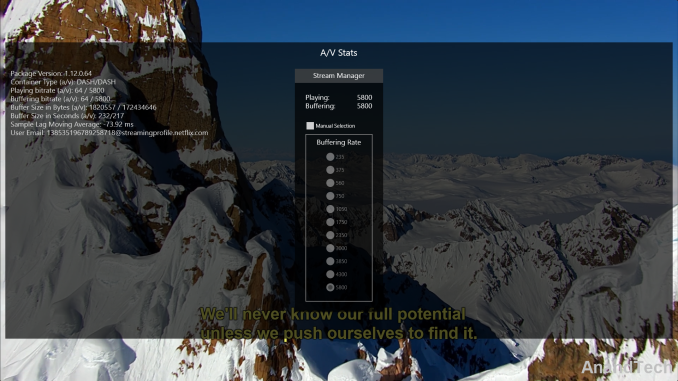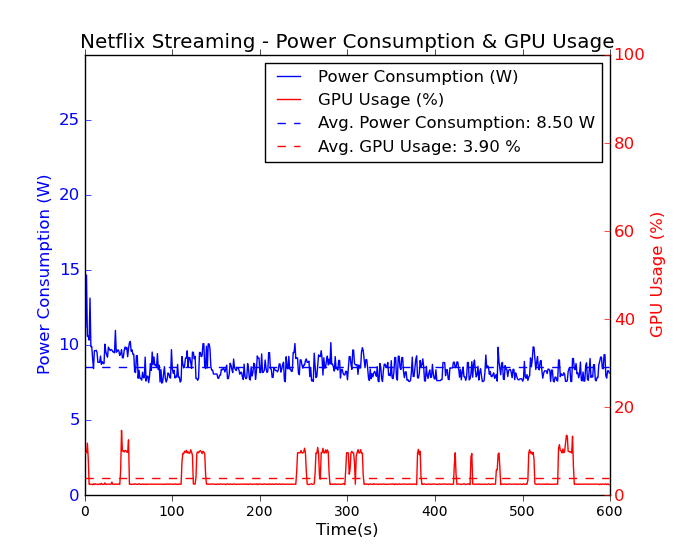Intel's Haswell NUC: D54250WYK UCFF PC Review
by Ganesh T S on January 3, 2014 4:25 PM ESTNetworking Performance and Streaming Aspects
In this section, we will take a look at the networking capabilities of the unit and also our standard HTPC streaming tests (involving YouTube and Netflix). Starting with this review, we are standardizing our evaluation of the wireless networking capabilities of UCFF and industrial PCs. Our standard test router is the Netgear R7000 Nighthawk configured with both 2.4 GHz and 5 GHz networks. The router is placed approximately 20 ft. away, separated by a drywall (as in typical US buildings). A wired client (Zotac ID89-Plus) is connected to the R7000 and serves as one endpoint for jPerf evaluation. The UCFF PC is made to connect to the two wireless SSIDs and jPerf tests are conducted for both TCP and UDP transfers with pre-set transfer parameters.
In our NUC build, Intel's Dual-Band Wireless-7260 delivers 2T2R 802.11ac speeds and provides very good throughput numbers when used with an appropriate router. As the gallery below shows, the 2.4 GHz band is able to deliver TCP throughput in the region of 86 Mbps and UDP throughput in the region of 96 Mbps.
The theoretical bandwidth number for 2x2 802.11ac is 867 Mbps. Practically, in the 5 GHz band, the 7260's TCP throughput is around 210 Mbps and UDP throughput is around 239 Mbps in our test setup.
Network Streaming Performance - Netflix and YouTube
YouTube and Netflix are two very popular streaming services utilized on HTPCs. With Windows 8, Silverlight is no longer necessary for Netflix streaming. The Netflix app on Windows 8 supports high definition streams (up to 5.8 Mbps) as well as 5.1-channel Dolby Digital Plus audio on selected titles.
It is not immediately evident whether GPU acceleration is available or not from the OSD messages. However, GPU-Z reported an average GPU utilization of 4% throughout the time that the Netflix app was playing back video. The average power consumption was around 8.5 W. Coming it at less than 10 W for the whole system while streaming HD video is very impressive. The spikes in the GPU usage were observed whenever the subtitles or control OSD kicked in. There is obviously some correlation between these spikes and the recorder power consumption at the wall.
One of the issues that I faced with the Netflix app was that bitstreaming HD audio (Dolby Digital Plus) would just not work. The playback was jerky to the point of being unwatchable and with either no or intermittent audio output to the AV receiver. Apparently, this is an issue faced by multiple users, and the problem stems from the Intel Display Audio Driver. Intel's rep on the forums, however, has been unable to reproduce the issue. So, it looks like many users are being left high and dry, unable to take advantage of one of the most important aspects of running Netflix as a Metro app.
Unlike Silverlight, Adobe Flash continues to maintain some relevance right now. YouTube continues to use Adobe Flash to serve FLV (at SD resolutions) and MP4 (at both SD and HD resolutions) streams. YouTube's debug OSD indicates whether hardware acceleration is being used or not.
Despite Windows 8 having plenty of YouTube apps, the browser interface is pretty much functional and free of external intrusive ads. The graph below shows the power consumption and GPU loading when playing a YouTube video in full screen using the Adobe Flash plugin on Mozilla Firefox.
The average GPU load is pretty constant around 8%, but power consumption at the wall has spikes corresponding to bursts of network activity. These bursts die down towards the end, after the full video gets buffered.
We saw that Haswell provided great power benefits for such network streaming activities in our HTPC piece at launch time. The Intel NUC takes this power benefit one step further by using a ULV processor. With a power consumption of less than 10 W for these activities, we are approaching dedicated media streamers' territory with the added flexibility of a full-blown PC at one's disposal.




















107 Comments
View All Comments
fluxtatic - Sunday, January 5, 2014 - link
Yeah, but isn't having options grand? In your theoretical example, I'm now paying for a bunch of stuff I don't use - battery, screen, kb, etc. Assuming I want strictly something to plug into the TV and shove into a cabinet.For me, I'm seriously considering a NUC for when I replace my wife's PC next summer. There's currently a mid-ATX tower on the coffee table in my living room, and I'm definitely going smaller next time around. Now it's just a question of how small I can go for the money it will cost.
To be honest, though, the discussion would be very nearly settled if there were Mini-ITX options for AMD FM2 processors. Haswell's nice, but I don't know that I can bring myself to pay Intel prices when the time comes.
Gigaplex - Sunday, January 5, 2014 - link
If the laptop is cheaper then you're not really paying for the screen etc. You're getting a discount with the caveat that those extras that you don't want are bolted on.darwinosx - Saturday, January 4, 2014 - link
Interesting but I'll wait for the Haswell Mac Mini.Lundmark - Saturday, January 4, 2014 - link
I thought about that too. Who knows for how long we have to wait, though? The Mac mini was neglected for almost three years before the current design replaced it.TheinsanegamerN - Saturday, January 4, 2014 - link
2014: mac mini with core i7 4750hq and iris pro.LuckyKnight - Sunday, January 5, 2014 - link
I've had one of these since they came out in the UK and it's a very good as a dedicated streaming device running XBMC on Linux. You can set the minimal fan speed to 20% in the BIOS and it runs practically silent. If it needs to ramp up (say when playing a game on a emulator then it can).The only bad thing is the cost of the unit (with mSSD, RAM).
airi - Sunday, January 5, 2014 - link
Yes, please look into writing Linux articles and integrating Linux into hardware reviews.Aikouka - Monday, January 6, 2014 - link
I have i3 Haswell NUC, and it's a pretty good unit all-around. I'm currently waiting for a good fanless third-party case, because while the NUC is fairly quiet, it's still audible in a quiet room. The fan's noise is also a little whiny, which I am not a fan of. There are announcements for fanless options that will provide 2.5" drive options as well, which could be good for creating a network-based DVR.As for the inability to bitstream, I have that exact same problem, and it's rather bewildering. My NUC was fine as I could bitstream without any problems in PLEX (WASAPI is the only option for bitstreaming in PLEX). As you can guess based on my choice in verb tense, I have the problem now, but it's strange how it appeared. Everything was fine until I loaded up a TV stream (networked from an InfiniTV 6 ETH) in WMC7, and I noticed that I wasn't getting any sound. Now, I can no longer bitstream in PLEX. I also cannot bitstream on my i3-3225-based HTPC either. I've also had this problem on an i7 860 + GTX 660 Ti system as well, but that went away with a graphics driver upgrade.
Anyway, you can get a temporary fix on the problem by setting your speaker configuration up in Windows, and telling your front-end (XBMC, PLEX, etc.) that your receiver is not Dolby Digital- and DTS-compatible. So, now my AVR just says "MULTI-CH IN" all the time as it's just getting a PCM stream from the PC.
ganeshts - Monday, January 6, 2014 - link
There is no problem with the bitstreaming from MPC-HC or any of the other media players which support that... It is only within XBMC in DirectSound mode and Netflix app.That said, I was able to bitstream successfully even from OpenELEC (which means users don't have to pay the Windows tax to make a very capable media streamer, except when Blu-ray menus are needed)
alpha754293 - Monday, January 6, 2014 - link
I wonder how this would compare - say to a Mac Mini. It seems that if the price difference between the two systems isn't more than $100-150 - why would I want to go with something like this vs. a Mac mini? (not to be an Apple fanboy or anything - but moreso for a complete pro/con analysis of each solution/type of solution in order to determine which is better in terms of technical specifications, performance, etc...)